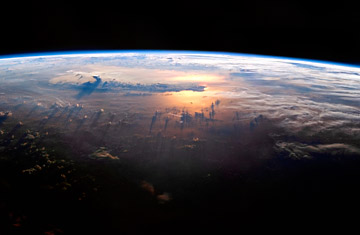
The Pacific Ocean seen from space — a cozy spot for extraterrestrial microbes to land. Image from Michael Benson's new book, 'Planetfall.'
(2 of 4)
LIFE ON MARS, the headlines screamed--including one in TIME--and that was exactly the conclusion the researchers had tentatively reached. "It's an unbelievable day," said then NASA administrator Daniel Goldin. "It took my breath away." President Clinton, campaigning for re-election, took a break to weigh in too. "If this discovery is confirmed," he said in a White House statement, "it will surely be one of the most stunning insights into our universe that science has ever uncovered."
Stunning, yes, but that confirmation never came. Further study of 84001 failed to rule out inorganic processes for the seemingly biological clues it contained, and while the rock continues to spark debate, no one disputes that the evidence was not the slam dunk it seemed to be.
In the years since, the research has proceeded apace, even if the press releases have been more measured, and the case for panspermia is being convincingly rebuilt. Last year, Herd and his co-authors published a paper in the journal Science showing not just how biological material could get to Earth but also how it could survive a long trip in space.
The study focused on what's known as the Tagish meteorite, after the frozen lake in British Columbia on which it smashed itself to fragments on Jan. 18, 2000. Within days of the impact, scientists collected the debris--making no direct hand contact with it in order to prevent biological contamination--and put it in cold storage. When Herd and his colleagues got hold of four of the fragments and cracked them open, they found that the debris very much warranted such caretaking.
Distributed throughout the rock were not just the organics that had been seen before but also organics in different stages of sophistication, with simpler molecules giving way to complex ones and more complex ones still--a bit like finding caterpillars, cocoons and butterflies all in the same little nest. The rock, it seemed, had been acting as a sort of free-flying incubator, with traces of water trapped in its matrix combining with heat from radioactive elements to keep things warm and effectively pulsing.
"These asteroids form in space, you dump in organic molecules, a little water ice and a little heat, and then they just start to stew," says Herd. That slow cooking went on for millions of years until the heat and water eventually were exhausted and the process shut down.
This doesn't have to mean that similar rocks landing on Earth billions of years ago were the start of all terrestrial life--or even that they contributed to biological processes already under way. And yet the organics in the Tagish meteorite have a curiously familiar feature. Amino acids come in one of two varieties: left-handed and right-handed, defined by an asymmetrical structure that points either one way or the other. All earthly life uses the left-handed kind--a puzzle since right-handed amino acids should work just as well--and the Tagish amino acids are left-handed too. Somehow, that southpaw bias got started on Earth. Herd's findings at least suggest that the influence could have come from beyond.
Cosmic Stowaways
